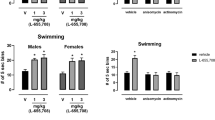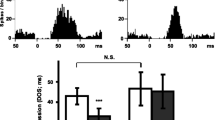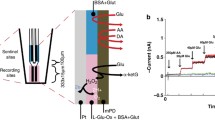Abstract
Previous studies from our laboratory have demonstrated that low doses of selective sigma (σ) ligands potentiate the neuronal response to N-methyl-D-aspartate (NMDA) in the CA3 region of the rat dorsal hippocampus. Sertraline and clorgyline, two antidepressant drugs with a high affinity for receptors, also potentiate, at low doses, the NMDA response; however, when administered at higher σ doses, the degree of potentiation induced by these two ligands progressively decreases (Bergeron et al. 1993). In the present experiments, the selective σ ligands DTG, ( + )pentazocine, BD-737, JO-1784 and L-687,384 were studied to determine if they would also generate bell-shaped dose-response curves. These ligands were administered intravenously at doses ranging from 1 μg/kg to 1 μg/kg or applied by microiontophoresis. They potentiated selectively, with bell-shaped dose-response curves, the NMDA-induced activation of pyramidal neurons in the CA3 region of the rat dorsal hippocampus. The potentiation of the NMDA response following the intravenous administration of a low dose of a σ ligand persisted for at least 60 min, after which point in time a second injection of the same dose induced the same degree of potentiation. Moreover, a sustained potentiation was obtained during prolonged microiontophoretic applications of a σ ligand. These two latter series of observations suggest that the lack of effect of the high doses of 6 ligands is not related to a rapid desensitisation of σ receptors. This biphasic effect of ligands might be due to the concomitant actions of these σ ligands on distinct subtypes of σ receptors.
Similar content being viewed by others
References
Barnes JM, Barnes NM, Barber PC, Champaneria S, Costall B, Hornsby CD, Ironside JW, Naylor RJ (1992) Pharmacological comparison of the sigma recognition site labelled by [3H]haloperidol in human and rat cerebellum. Naunyn Schmiedeberg's Arch Pharmacol 345:197–202
Bergeron R, Debonnel G, de Montigny C (1993) Modification of the N-methyl-D-aspartate response by antidepressant sigma receptor ligands. Eur J Pharmacol 240:319–323
Bouchard P, Dumont Y, Fournier A, St.-Pierre S, Quirion R (1993) Evidence for in vivo interactions between neuropeptide Y-related peptides and receptors in the mouse hippocampal formation. J Neurosci 13:3926–3931
Carr DJ, Mayo S, Woolley TW, de Costa BR (1992) Immunoregulatory properties of (+)-pentazocine and sigma ligands. Immunology 77:527–531
Contreras PC, Ragan DM, Bremer ME, Lanthorn TH, Gray NM, Iyengar S, Jacobson AE, Rice KC, de Costa BR (1991) Evaluation of U-50,488H analogs for neuroprotective activity in the gerbil. Brain Res 546:79–82
Cotman CW, Monaghan DT (1988) Excitatory amino acid neurotransmission: NMDA receptors and Hebb-Type synaptic plasticity. Ann Rev Neurosci 11:288–293
Debonnel G (1993) Current hypotheses on sigma receptors and their physiological role: possible implications in psychiatry. J Psychiatry Neurosci 18:157–172
Earley B, Burke M, Leonard BE, Gouret CJ, Junien JL (1991) Evidence for an anti-amnesic effect of JO 1784 in the rat: a potent and selective ligand for the sigma receptor. Brain Res 546:282–286
Ferris RM, Tang FL, Chang KJ, Russell A (1986) Evidence that the potential antipsychotic agent rimcazole (BW 234 U) is a specific, competitive antagonist of sigma sites in brain. Life Sci 38:2329–2337
Fudenberg HH, Whitten HD, Chou YK, Arnaud P, Shums AA, Khansari NK (1984) Sigma receptors and autoimmune mechanisms in schizophrenia: preliminary findings and hypotheses. Biomed Pharmacother 38:285–290
Haigler HJ, Aghajanian GK (1974) Lysergic acid diethylamide and serotonin; A comparison of effects on serotonergic neurons receiving a serotonergic input. J Pharmacol Exp Ther 168:688–699
Itzhak Y, Kassim CO (1990) Clorgyline displays high affinity for sigma-binding sites in C57BL/6 mouse brain. Eur J Pharmacol 176:107–108
Itzhak Y, Stein I (1990) Sigma binding sites in the brain; an emerging concept for multiple sites and their relevance for psychiatric disorders. Life Sci 47:1073–1081
Itzhak Y, Stein I, Zhang SH, Kassim CO, Cristante D (1991) Binding of sigma-ligands to C57BL/6 mouse brain membranes: effects of monoamine oxidase inhibitors and subcellular distribution studies suggest the existence of sigma-receptor subtypes. J Pharmacol Exp Ther 257:141–148
Iyengar S, Wood PL, Mick SJ, Dilworth VM, Gray NM, Farah JM, Rao TS, Contreras PC (1991) (+) 3-[3-hydroxyphenyl-N-(1-propyl) piperidine] selectively differentiates effects of sigma ligands on neurochemical pathways modulated by sigma receptors: evidence for subtypes, in vivo. Neuropharmacology 30:915–922
Junien JL, Gue M, Pascaud X, Fioramonti J, Bueno L (1990) Selective stimulation of colonic motor response to a meal by sigma ligands in dogs. Gastroenterology 99:684–689
Largent BL, Gundlach AL, Snyder SH (1984) Psychotomimetic opiate receptors labeled and visualized with (+)[3H]3–3(3-hydroxyphenyl)-N-(1-propyl)piperidine. Neurobiology 81:4983–4987
Largent BL, Gundlach AL, Snyder SH (1986) Pharmacological and autoradiographic discrimination of sigma and phencyclidine receptor binding sites in brain with (+)-[3H]SKF 10,047, (+)[3H]-3-[3-hydroxyphenyl]-N-(1-propyl)piperidine and [3H]-l-[1-(2-thienyl)cyclohexyl]piperidine. J Pharmacol Exp Ther 238:739–748
Magnusson O, Fowler CJ (1989) Comparison of the effects of the novel antipsychotic agent remoxipride on dopamine and noradrenaline turnover in the rat brain. Pharmacol Toxicol 65:295–298
Martin WR, Eades CG, Thompson JA, Huppler RE, Gilbert PE (1976) The effects of morphine and nalorphine-like drugs in the nondependent and morphine-dependent chronic spinal dog. J Pharmacol Exp Ther 197:517–532
Martin WJ, Roth JS, Walker JM (1992) The effects of sigma compounds on both NMDA-and non NMDA-mediated neuronal activity in rat hippocampus. Soc Neurosci Abst 18:16.6
Maurice T, Hiramatsu M, Itoh J, Kameyama T, Hasegawa T, Nabeshima T (1994a) Behavioral evidence for a modulating role of ligands in memory processes. I. Attenuation of dizocilpine (MK-801)-induced amnesia. Brain Res 647:44–56
Maurice T, Hiramatsu M, Kameyama T, Hasegawa T, Nabeshima T (1994b) Behavioral evidence for a modulating role of ligands in memory processes. II. Reversion of carbon monoxide-induced amnesia. Brain Res 647:57–64
McMillan DE, Hardwick WC, DeCosta BR, Rice KC (1991) Effects of drugs that bind to PCP and sigma receptors on punished responding. J Pharmacol Exp Ther 258:1015–1018
Middle miss DN, Billington D, Chambers M, Hutson PH, Knight A, Russell M, Thorn L, Tricklebank MD, Wong EHF (1991) L-687,384 is a potent, selective ligand at the central sigma recognition site. Br J Pharmacol 102:153
Monnet FP, Debonnel G, Junien JL, de Montigny C (1990a) N-methyl-D-aspartate-induced neuronal activation is selectively modulated by sigma receptors. Eur J Pharmacol 179:441–445
Monnet FP, Debonnel G, de Montigny C (1990b) Neuropeptide-Y Selectively Potentiates N-Methyl-D-Aspartate-Induced Neuronal Activation. Eur J Pharmacol 182:207–208
Monnet FP, Blier P, Debonnel G, de Montigny C (1992a) Modulation by sigma ligands of N-methyl-D-aspartate-induced [3H]noradrenaline release in the rat hippocampus: G-protein dependency. Naunyn Schmiedeberg's Arch Pharmacol 346:32–39
Monnet FP, Debonnel G, de Montigny C (1992b) In vivo electrophysiological evidence for a selective modulation of N-methylD-aspartate-induced neuronal activation in rat CA3 dorsal hippocampus by sigma ligands. J Pharmacol Exp Ther 261:123–130
Paxinos G, Watson C (1986) The rat brain in stereotaxic coordinates, 2nd edn. Academic Press, Orlando, Florida
Quirion R, Bowen WD, Itzhak Y, Junien JL, Musacchio JM, Rothman RB, Su TP, Tam SW, Taylor DP (1992) A proposal for the classification of sigma binding sites. Trends Pharmacol Sci 13:85–86
Rao TS, Mick SJ, Cler JA, Emmett MR, Dilworth VM, Contreras PC, Gray NM, Wood PL, Iyengar S (1991) Effects of sigma ligands on mouse cerebella cyclic guanosine monopbosphate (cGMP) levels in vivo: further evidence for a functional modulation of N-methyl-D-aspartate (NMDA) receptor complex-mediated events by sigma ligands. Brain Res 561:43–50
Ranck JB (1975) Behavioral correlates and firing repertoires of neurons in dorsal hippocampul formation and septum of unrestrained rats In: (eds) Isaacson RL, Pribram KH The Hippocampus, Plenum Press, New York, London, p 207
Roman F, Pascaud X, Vaucbe D, Junien JL (1988) Evidence for a non-opioid sigma binding site in the guinea-pig myenteric plexus. Life Sci 42:2217–2222
Roman FJ, Pascaud X, Duffy O, Vauche D, Martin B, Junien JL (1989) Neuropeptide-Y and peptide-YY interact with rat brain-sigma and PCP binding sites. Eur J Pharmacol 174:301–302
Roman FJ, Pascaud X, Martin B, Vauche D, Junien JL (1990) JO-1784, a potent and selective ligand for rat and mouse brain sigma sites. J Pharm Pharmacol 42:439–440
Roman FJ, Pascaud X, Duffy O, Junien JL (1991) Modulation by neuropeptide Y and peptide YY of NMDA effects in hippocampal slices: Role of sigma receptors. In: Kameyama T, Nabeshima T, Domino EF (eds) NMDA Receptors related agents: biochemistry, pharmacology and behavior. NPP Books, Ann Arbor, pp 211–218.
Schmidt A, Lebel L, Koe BK, Seeger T, Heym J (1989) Sertraline potently displaces (+)-[3H]3-PPP binding to sigma-sites in rat brain. Eur J Pharmacol 165:335–336
Snyder SH, Largent BL (1989) Receptor mechanisms in antipsychotic drug action: focus on sigma receptors. J Neuropsychiatry Clin Neurosci 1:7–15
Steinfels GF, Alberici GP, Tam SW, Cook L (1988) Biochemical, behavioral, and electrophysiologic actions of the selective sigma receptor ligand (+)-pentazocine. Neuropsychopharmacology 1:321–327
Su TP (1982) Evidence for sigma opioid receptor: binding of [3H]SKF-10047 to etorphine-inaccessible sites in guinea-pig brain. J Pharmacol Exp Ther 223:284–290
Su TP (1993) Pharmacologic characterizations of sigma receptors. NIDA Res Monogr 133:41–53SW (1983) Naloxone-inaccessible sigma receptor in rat central nervous system. Proc Natl Acad Sci USA 80:6703–6707
Su TP, Schell SE, Ford-Rice FY, London ED (1988) Correlation of inhibitory potuncies of putative antagonists for sigma receptors in brain and spleen. Eur J Pharmacol 148:467–470
Tam SW, Cook L (1984) Sigma opiates and certain antipsychotic drugs mutually inhibit (+)-[3H] SKF 10,047 and [3H]haloperidol binding in guinea pig brain membranes. Proc Natl Acad Sci USA 81:618–5621
Taylor DP, Dekleva J (1987) Potential antipsychotic BMY 14802 selectively binds to sigma sites. Drug Dev Res 11:65–70
Taylor DP, Eison, MS, Moon SL, Yocca FD (1989) BMY 14802: A potential antipsychotic with selective affinity for sigma sites. In: Tamminga CA, Schulz SC (eds) Schizophrenia. Raven Press, New York, pp 1–19
Thomas GE, Szucs M, Mamone JY, Bern WT, Rush MD, Johnson FE, Coscia CJ (1990) Sigma and opioid receptors in human brain tumors. Life Sci 46:1279–1286
Walker JM, Bowen WD, Walker FO, Matsumoto RR, de Costa B, Rice KC (1990) Sigma receptors: biology and function. Pharmacol Rev 42:355–402
Walker JM, Bowen WD, Goldstein SR, Roberts AH, Patrick SL, Hohmann AG, de Costa B (1992) Autoradiographic distribution of [3H](+)-pentazocine and [3H] 1,3-di-o-tolylguanidine (DTG) binding sites in guinea pig brain: a comparative study. Brain Res 581:33–38
Walker M, Hunter WS (1994) Role of sigma receptors in motor and limbic system function. Neuropsychopharmacology 10:837s
Weber E, Sonders M, Quarum M, McLean S, Pon S, Keana JF (1986) 1,3-Di(2-[5–3H]tolyl)guanidine: a selective ligand that labels sigma-type receptors for psychotomimetic opiates and antipsychotic drugs. Proc Natl Acad Sci USA 83:8784–8788
Wood PL (1991) Pharmacology of the second messenger, cyclic guanosine 3′,5′-monopbosphate, in the cerebellum. Pharmacol Rev 43:1–25
Author information
Authors and Affiliations
Rights and permissions
About this article
Cite this article
Bergeron, R., de Montigny, C. & Debonnel, G. Biphasic effects of sigma ligands on the neuronal response to N-methyl-D-aspartate. Naunyn-Schmiedeberg's Arch Pharmacol 351, 252–260 (1995). https://doi.org/10.1007/BF00233244
Received:
Accepted:
Issue Date:
DOI: https://doi.org/10.1007/BF00233244




